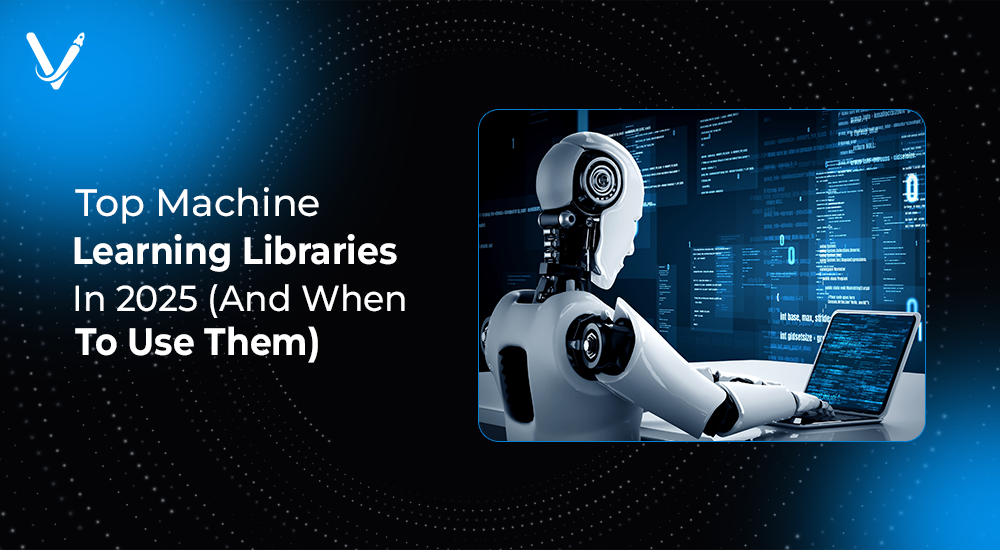Top Machine Learning Libraries in 2025 (And When to Use Them)


- Jun 25, 2025
Machine learning is no longer a niche skill reserved for data scientists in lab coats. In 2025, it's a core technology powering everything from voice assistants to healthcare diagnostics, fraud detection to personalized marketing. As the field evolves, so do the tools available to developers and data teams. Choosing the right machine learning library isn’t just a technical decision—it impacts performance, scalability, and delivery timelines.
This comprehensive guide covers the most widely used, community-supported, and production-grade machine learning libraries in 2025. You’ll learn what each library excels at, when to use it, and how to integrate it into your workflow for maximum value.
Every ML project has unique requirements—data types, latency goals, scalability needs, interpretability demands, and deployment environments. Picking the wrong tool can mean weeks of rework, bloated pipelines, or underperforming models.
The right library, however:
Whether you're building a recommendation engine, a generative AI tool, or an edge-deployed vision model, choosing the right foundation sets you up for success.
Google's TensorFlow remains a top choice in 2025 for scalable deep learning solutions. With full support for distributed training, hardware acceleration (TPUs and GPUs), and production pipelines via TensorFlow Extended (TFX), it’s ideal for enterprise-grade applications.
Use Case: Healthcare startup training a multi-modal model combining images and text, deployed across hospitals using TensorFlow Lite for on-device inference.
Developed by Meta and beloved by researchers, PyTorch has become the preferred library for experimentation and academic work. Its dynamic computation graph makes debugging and iteration easier than TensorFlow's static graph model.
By 2025, PyTorch has matured into a production-ready framework with TorchServe, TorchScript, and ONNX export support.
Use Case: AI lab prototyping a new transformer model for document summarization and publishing open-source implementations using PyTorch Lightning.
Scikit-learn continues to be the go-to library for classical machine learning algorithms like logistic regression, decision trees, SVMs, and clustering. It's ideal for tabular data and works well in environments that don’t require deep learning.
Use Case: Financial services company building a churn prediction model using logistic regression and random forests.
Hugging Face has become synonymous with transformer-based NLP. Their transformers library supports hundreds of pre-trained models like BERT, GPT, T5, and more, with simple APIs and deep integration with PyTorch and TensorFlow.
Use Case: E-commerce platform fine-tuning a multilingual sentiment classifier for customer reviews using the transformers library.
JAX is gaining ground in 2025, particularly in academic and scientific communities. It combines NumPy-like APIs with automatic differentiation and supports just-in-time (JIT) compilation via XLA for massive speedups.
Use Case: Research team at a university optimizing custom loss functions and simulating stochastic processes using JAX.
For structured data, gradient boosting remains undefeated. LightGBM (by Microsoft) and XGBoost (by DMLC) dominate Kaggle competitions and real-world deployments.
Use Case: Telecom company using LightGBM for customer segmentation, achieving high ROC-AUC with minimal feature engineering.
Keras, now tightly integrated with TensorFlow 2.x, offers a high-level API that simplifies deep learning for beginners and teams that value rapid iteration.
Use Case: Startup testing different CNN architectures for image classification with minimal code using Keras.
Built on PyTorch, FastAI is designed to enable developers to train state-of-the-art models with minimal code. It abstracts away much of the complexity of PyTorch while retaining flexibility.
Use Case: EdTech platform training models to classify hand-drawn equations submitted by students using FastAI.
ONNX (Open Neural Network Exchange) is not a library but a standard format that allows ML models to be transferred between frameworks like PyTorch, TensorFlow, and Caffe2.
Use Case: Robotics company exporting PyTorch models to ONNX and deploying them in C++ on embedded systems.
MLflow isn't a model training library but a tool to manage ML experiments, track metrics, and deploy models. It's framework-agnostic and integrates with most popular libraries.
Use Case: Retail chain managing hundreds of forecasting models across regions using MLflow for versioning and deployment.
Excellent for categorical data, native support for categorical features without encoding.
Tailored for drug discovery and molecular ML applications.
GPU-accelerated libraries for data science pipelines using cuDF and cuML.
Best for building NLP-powered search systems with transformers.
Low-code deep learning library that enables model training with declarative configs.
When selecting a machine learning library in 2025, consider:
Pro Tip: Benchmark with a small prototype across 2–3 libraries. Measure accuracy, training time, developer productivity, and deployment complexity.
The machine learning landscape in 2025 is vast, vibrant, and evolving fast. The good news? You don’t need to master every library. You just need to choose the right one for the task at hand.
By aligning your project needs with the strengths of each ML library, you set your team up for efficient development, reliable performance, and long-term scalability.
At Vasundhara Infotech, we help businesses select, integrate, and optimize the best machine learning libraries for their specific goals. Whether you're building an AI MVP or scaling an enterprise solution, we’re here to guide you. Contact us to unlock real value with machine learning.
Copyright © 2025 Vasundhara Infotech. All Rights Reserved.
